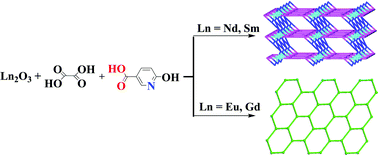Two- and three-dimensional lanthanide–organic frameworks constructed using 1-hydro-6-oxopyridine-3-carboxylate and oxalate ligands†
Abstract

* Corresponding authors
a
Beijing National Laboratory for Molecular Sciences, Center for Molecular Science, Institute of Chemistry, Chinese Academy of Sciences, Beijing 100190, P. R. China
E-mail:
cmliu@iccas.ac.cn
Fax: +86 1062559373
Tel: +86 1082615007
b Geoscience Laboratory, China University of Geoscience, Beijing 100083, P. R. China
c College of Chemistry and Life Science, Tianjin Normal University, Tianjin, P. R. China

 Please wait while we load your content...
Something went wrong. Try again?
Please wait while we load your content...
Something went wrong. Try again?
C. Liu, M. Xiong, D. Zhang, M. Du and D. Zhu, Dalton Trans., 2009, 5666 DOI: 10.1039/B903613J
To request permission to reproduce material from this article, please go to the Copyright Clearance Center request page.
If you are an author contributing to an RSC publication, you do not need to request permission provided correct acknowledgement is given.
If you are the author of this article, you do not need to request permission to reproduce figures and diagrams provided correct acknowledgement is given. If you want to reproduce the whole article in a third-party publication (excluding your thesis/dissertation for which permission is not required) please go to the Copyright Clearance Center request page.
Read more about how to correctly acknowledge RSC content.
 Fetching data from CrossRef.
Fetching data from CrossRef.
This may take some time to load.
Loading related content
